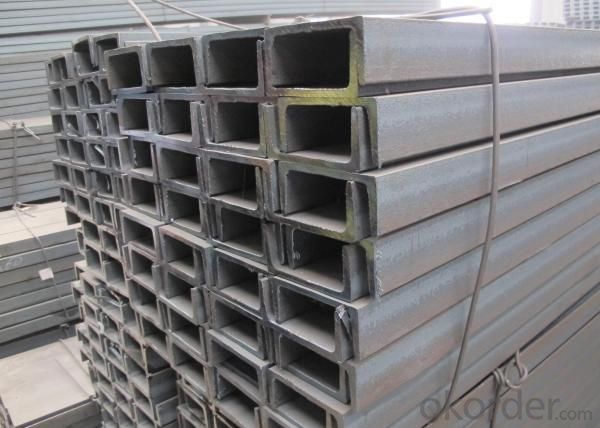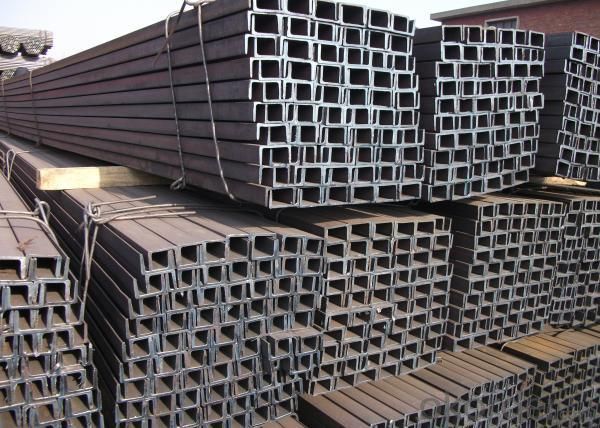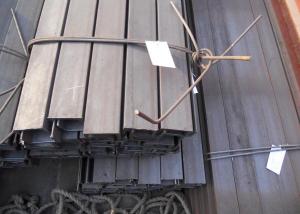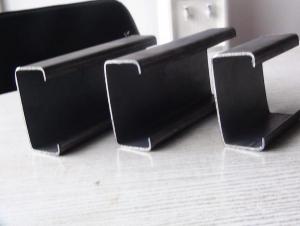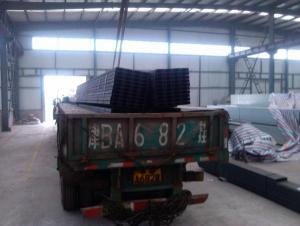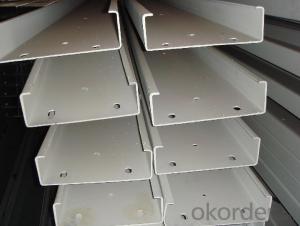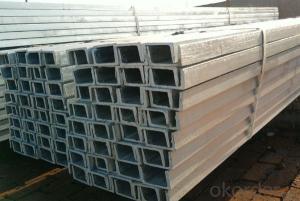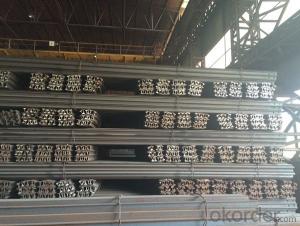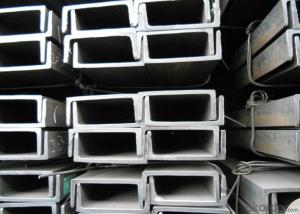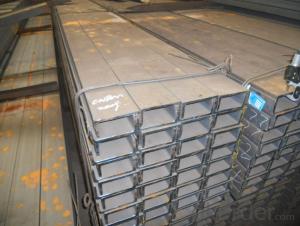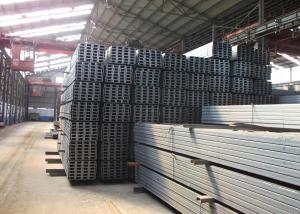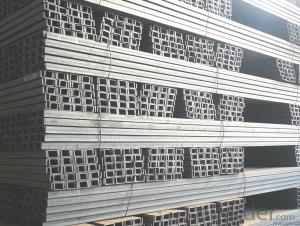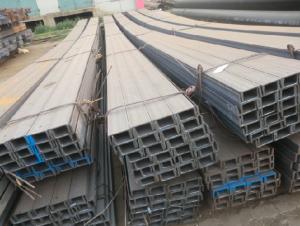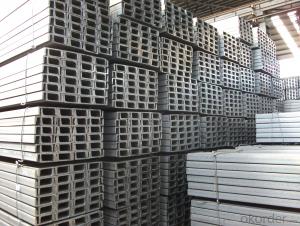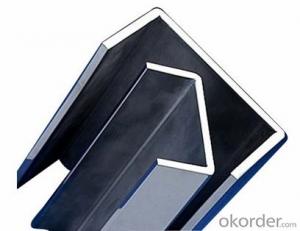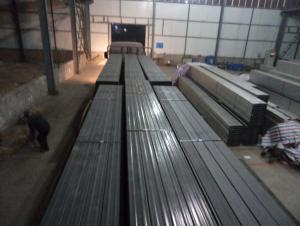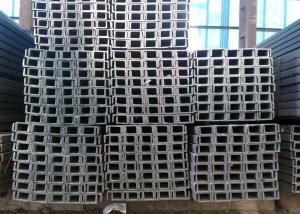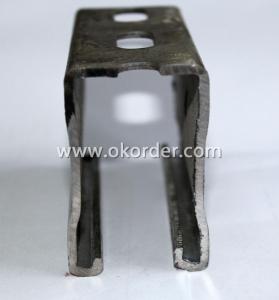Steel U Channel
- Loading Port:
- Xingang Port
- Payment Terms:
- TT or L/C
- Min Order Qty:
- 25 Tons m.t.
- Supply Capability:
- 1000 Tons Per Day m.t./month
OKorder Service Pledge
OKorder Financial Service
You Might Also Like
Specifications of Steel U Channel:
Standard Applied: GB Standard, EN Standard(UPN), JIS Standard
Sizes: 50mm to 300mm
Material Grade: Q235B, Q345B, S235JR, SS400, ASTM A36
As shown in the figure:
|
JIS U CHANNEL |
Standard h |
Sectional b |
Dimension s |
t |
Mass: Kg/m |
|
(mm) |
(mm) |
(mm) |
(mm) |
||
|
50x25 |
50 |
25 |
3.0 |
6.00 |
2.37 |
|
75X40 |
75 |
40 |
3.8 |
7.00 |
5.30 |
|
75X40 |
75 |
40 |
4.0 |
7.00 |
5.60 |
|
75X40 |
75 |
40 |
4.5 |
7.00 |
5.85 |
|
75X40 |
75 |
40 |
5.0 |
7.00 |
6.92 |
|
100X50 |
100 |
50 |
3.8 |
6.00 |
7.30 |
|
100X50 |
100 |
50 |
4.2 |
6.00 |
8.03 |
|
100X50 |
100 |
50 |
4.5 |
7.50 |
8.97 |
|
100X50 |
100 |
50 |
5.0 |
7.50 |
9.36 |
|
125X65 |
125 |
65 |
5.2 |
6.80 |
11.66 |
|
125X65 |
125 |
65 |
5.3 |
6.80 |
12.17 |
|
125X65 |
125 |
65 |
5.5 |
8.00 |
12.91 |
|
125X65 |
125 |
65 |
6.0 |
8.00 |
13.40 |
|
150x75 |
150 |
75 |
5.5 |
7.30 |
14.66 |
|
150x75 |
150 |
75 |
5.7 |
10.00 |
16.71 |
|
150x75 |
150 |
75 |
6.0 |
10.00 |
17.90 |
|
150x75 |
150 |
75 |
6.5 |
10.00 |
18.60 |
Note: We are able to supply other dimensions and sizes, which depends on the customer's requirements for the quantity.
Chemical Composition of Q235B Steel U Channel:
|
Alloy No |
Grade |
Element(%) | ||||
|
C |
Mn |
S |
P |
Si | ||
|
Q235 |
B |
0.12-0.20 |
0.3-0.7 |
≦0.045 |
≦0.045 |
≦0.3 |
Physical Properties of Q235B Steel U Channel:
|
Grade |
Yielding Strength Point(Mpa) | ||||
|
Q235B |
Thickness(mm) | ||||
|
≦16 |
>16-40 |
>40-60 |
>60-100 | ||
|
≧235 |
≧225 |
≧215 |
≧205 | ||
|
Tensile Strength(Mpa) |
Elongation After Fracture(%) | ||||
|
Thickness(mm) | |||||
|
≦16 |
>16-40 |
>40-60 |
>60-100 | ||
|
375-500 |
≧26 |
≧25 |
≧24 |
≧23 | |
Usage/Application of Steel U Channel:
The steel u channel can be applied to construction of warehouses, workshops, sport stadiums and car parks etc. In details, the steel u channel belongs to carbon structural steel which is applied to in the field of construction and machinery. The steel u channel is usually used for arch-itechtural structure, and they could be welded in order to support or hang a vari-ety of facilities. They are also usually used in combination with I beam. Generally,the steel u channel must possess perfect welding property, riveting property and mechanical property and so on.
Package & Delivery: Steel U Channel
The steel u channel will be packed in bundle with steel wire at each end of every bundle and color marking in order to help the customer to recognize his goods more easily at sight.
And steel u channel could be loaded into 20ft or 40ft container, or by bulk cargo. If the weight of each bundle reaches less than 3.5 mt, the loading by break bulk cargo should be choosed. When the weight of each bundle reaches less than 3mt, the loading by container should be choosed.
As for the transportaion from mill to loading port, the truck will be usually used. And the maximum quantity for each truck is 40mt.
All in all, we could do in accordance with customer's request
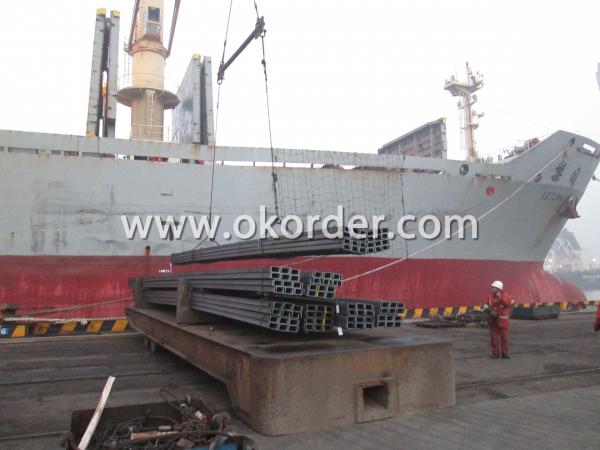
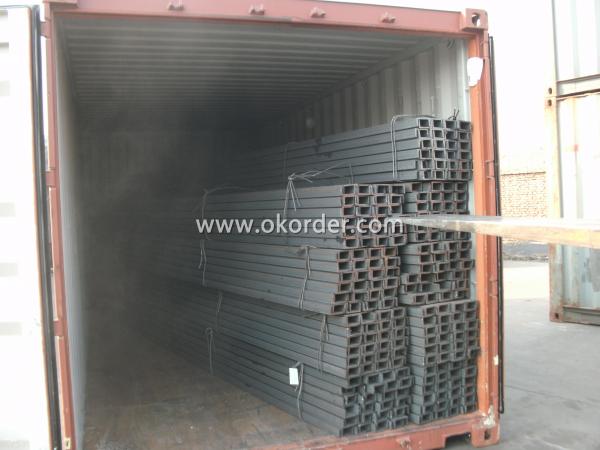
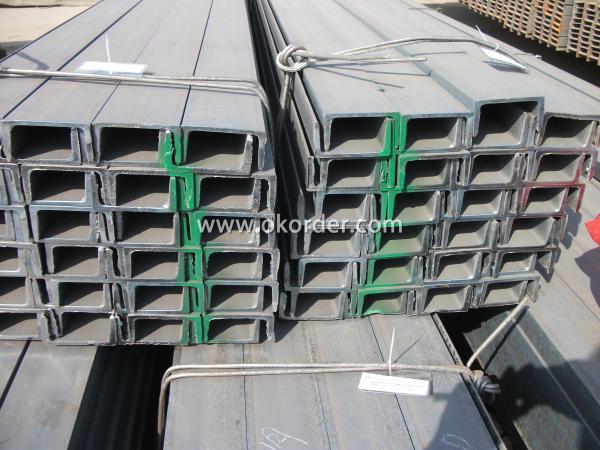
Production Flow of Steel U Channel:
1.The steel billet shall be heated in the high temperature furnace.
2. The heated steel billet shall be rolled five to nine times with the aim of shaping the general figure of steel u channel.
3. The rolled steel u channel should be put onto the cooling bed to make the temperature low.
4. The steel u channel should be straighted on the straightener.
5. The straighted steel u channel will be cut into meters by saw, as per customer's requirements.
- Q: Where can I find the tensile strength of channel steel?
- No, it depends on what you use in that area. Many of them can be divided into tensile strength, yield strength and specific termsThe concrete formula does not seem to be available. Only by experiment can we get the exact number
- Q: How do steel channels contribute to the overall durability of a structure?
- The overall durability of a structure is enhanced by steel channels in multiple ways. Firstly, they add strength and support to the structure, making it more resistant to different types of loads, such as compression, tension, and bending. This increased strength enables the structure to withstand external forces like strong winds, earthquakes, or heavy loads. Furthermore, steel channels function as load-bearing elements, transferring the weight of the structure and its contents to the foundation. By evenly distributing the load, steel channels prevent excessive stress on any particular area, thereby reducing the risk of structural failure or collapse. Moreover, steel channels exhibit high resistance to corrosion, which is a major concern in many structures, particularly those in humid or coastal areas. The utilization of steel channels prevents rusting and deterioration over time, ensuring the long-lasting structural integrity of the building. Additionally, steel channels offer versatility in terms of design and construction. They can be easily shaped and manipulated to meet the specific requirements of a structure, facilitating efficient and precise construction. This adaptability makes steel channels an excellent choice for a wide range of architectural designs and applications. In conclusion, steel channels enhance the overall durability of a structure by providing increased strength, load-bearing capabilities, corrosion resistance, and versatility. By incorporating steel channels into the construction process, buildings and other structures can withstand various external forces and maintain their structural integrity for an extended period.
- Q: Geometrical dimension of channel steel channel 8
- GB: 80*43*5.0 (height * width * thick waist and legs, mm), cross section area: 10.248cm - 10.007kg/m, weight
- Q: Can steel channels be used in curved structures?
- Yes, steel channels can be used in curved structures. Steel channels can be bent or curved to achieve the desired shape without compromising their structural integrity. This flexibility makes them suitable for various applications in curved structures such as bridges, arches, and curved beams.
- Q: Can steel channels be welded or bolted together?
- Yes, steel channels can be welded or bolted together.
- Q: Can steel channels be used for column supports?
- Yes, steel channels can be used for column supports. Steel channels are often used in construction and engineering projects for their strength and durability. They provide excellent support and help distribute the load evenly, making them suitable for column supports.
- Q: What are the different methods of rust prevention for steel channels?
- There are several methods of rust prevention for steel channels, including painting or coating the surface with corrosion-resistant materials, galvanizing the steel to create a protective zinc layer, applying rust inhibitors or sealants, implementing cathodic protection techniques, and regular maintenance and inspection to identify and address any signs of rust or corrosion.
- Q: Are steel channels suitable for use in bridges?
- Yes, steel channels are commonly used in the construction of bridges due to their high strength, durability, and ability to support heavy loads. They provide structural support and stability, making them suitable for use in bridges.
- Q: How do steel channels perform in high-seismic areas?
- Steel channels perform well in high-seismic areas due to their inherent strength and ductility. In seismic zones, the ground experiences intense shaking and lateral forces, which can cause buildings to undergo significant structural deformation. Steel channels, with their ability to flex and absorb energy, are better equipped to withstand these forces compared to other building materials. The shape of steel channels, with their flanges and web, provides enhanced strength and rigidity. This allows them to resist bending and twisting forces, ensuring the overall stability of structures in high-seismic areas. Furthermore, steel channels can be designed to have tapered flanges, which improves their load-carrying capacity and reduces the risk of buckling during seismic events. Another advantage of steel channels in high-seismic areas is their ability to dissipate energy. During an earthquake, the channel's flexible nature allows it to absorb and distribute the seismic forces, minimizing the impact on the structure. This energy absorption capability reduces the chances of structural damage and enhances the safety of occupants inside the building. Moreover, steel channels offer versatility in design and construction. They can be easily integrated into various structural systems, such as moment frames and braced frames, which are commonly used in earthquake-resistant buildings. This flexibility allows for efficient and cost-effective construction in high-seismic areas. Overall, steel channels provide reliable performance in high-seismic areas by offering strength, flexibility, and energy dissipation capabilities. Their ability to withstand intense shaking and lateral forces makes them a preferred choice for structural applications in seismic zones, ensuring the safety and resilience of buildings in such areas.
- Q: Can steel channels be used in multi-story buildings?
- Multi-story buildings can indeed utilize steel channels. These steel channels, also referred to as C-channels or structural channels, are commonly employed in construction due to their robustness and endurance. They offer structural reinforcement and are frequently employed as framing components in numerous applications, including multi-story buildings. Steel channels possess a combination of lightweight and strength, rendering them ideal for multi-story buildings where weight plays a critical role. Their fabrication and installation are simple, which reduces construction time and expenses. Furthermore, steel channels exhibit excellent resistance to fire, corrosion, and other environmental factors, ensuring the long-term stability and safety of the building. Within multi-story buildings, steel channels can be employed as beams, columns, or bracing elements to distribute the load and provide stability. They can withstand the weight of floors, walls, and roofs, while also enduring dynamic forces such as wind and seismic loads. Through meticulous engineering and design considerations, steel channels can efficiently manage the vertical and horizontal loads that arise in multi-story buildings. Moreover, steel channels can seamlessly integrate with other structural systems, such as steel frames or reinforced concrete, to establish a sturdy and adaptable building structure. Their versatility allows for a broad range of design possibilities, accommodating different architectural styles and functional requirements. In conclusion, steel channels are a suitable option for multi-story buildings due to their strength, durability, and versatility. They offer structural support, resist environmental factors, and can be easily integrated into the building's framework.
1. Manufacturer Overview
| Location | Hebei, China |
| Year Established | 1993 |
| Annual Output Value | Above US$100 Million |
| Main Markets | South Asia Middle East; Southeast Aisa; south Korea |
| Company Certifications | ISO 9001:2000 |
2. Manufacturer Certificates
| a) Certification Name | |
| Range | |
| Reference | |
| Validity Period |
3. Manufacturer Capability
| a) Trade Capacity | |
| Nearest Port | Tianjin; |
| Export Percentage | 1% - 10% |
| No.of Employees in Trade Department | 11-20 People |
| Language Spoken: | English; Chinese |
| b) Factory Information | |
| Factory Size: | Above 20,000 square meters |
| No. of Production Lines | 1 |
| Contract Manufacturing | OEM service offered |
| Product Price Range | average |
Send your message to us
Steel U Channel
- Loading Port:
- Xingang Port
- Payment Terms:
- TT or L/C
- Min Order Qty:
- 25 Tons m.t.
- Supply Capability:
- 1000 Tons Per Day m.t./month
OKorder Service Pledge
OKorder Financial Service
Similar products
Hot products
Hot Searches
Related keywords



